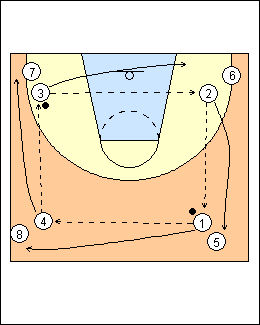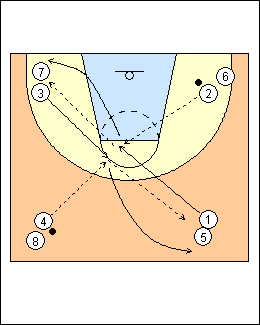4-corner
 | 1 Two balls.a) Counter-clockwise passing 1 passes to 2, 3 passes to 4, both follow their passes, and the pattern continues. Bob Bigelow - use the elbows and blocks with kids, start with one ball and chest passes. The passer should look at the receiver, who has to look at the passer and show his hands as a target. Geno Auriemma - have three balls going at once, players pass, run to the ball, catch the ball, pass back again (a shorter pass), and move to the line they passed to (going in front of the receiver). Bobby Knight - tight square (use the lane). 3 balls, pass, return pass, hand off, go inside to the back of the line. switch directions on "change", call out the name of the guy you are passing to. Coach Mac - swing passing - 1 passes in front of 2, who is jogging towards 7 and catches on the move, then 7 starts jogging towards the next line for a pass from 2. Variations See Passing - Triangle. |
 | 2 b) Clockwise passing 1 passes to 4, 3 passes to 2, both follow their passes, and the pattern continues. Variation - use a chest, bounce, overhead and push pass. |
 | 3 c) Pass in and out 1 runs diagonally across the grid, gets a pass on the right from 2, and passes ahead to 7. At the same time 3 runs across, gets a pass from 4 on the right and passes ahead to 5. 1 and 3 follow their passes. Options - chest pass in, bounce pass out - 1 gets a pass on the left from 4, 3 gets a pass from 2. |
 | 4 2 runs across for a pass from 7 and passes to 8, while 4 runs across for a pass from 5 and passes to 6. Tara VanDerveer (Gooroo) - 4-corner passing - use two balls, players look to their right then pass in front, repeat looking left, progressions - walking-jogging-running, try four balls. See Passing - Bill Self Seminole (4 balls). |
This page was made with Basketball playbook from Jes-Soft